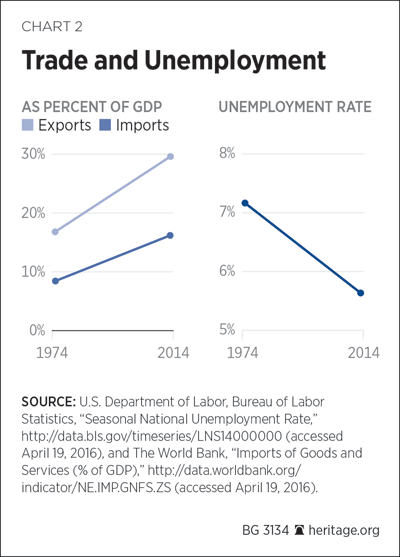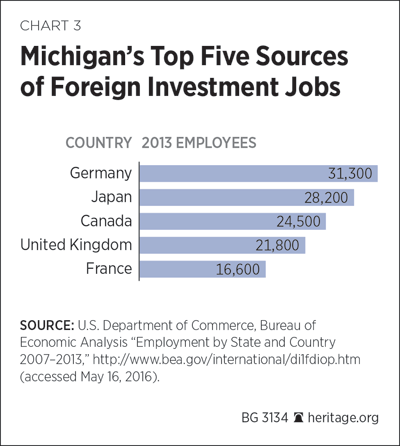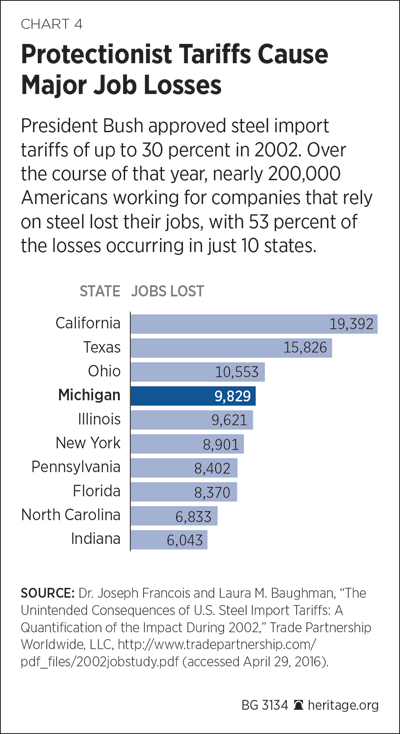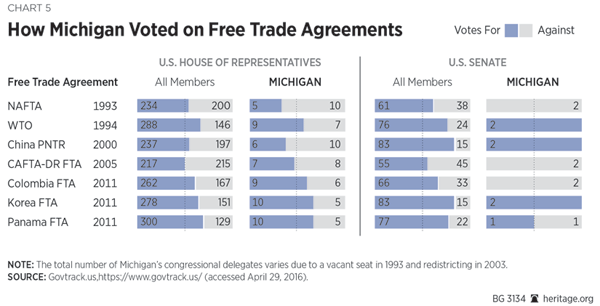Every Michigander remembers what the state’s economy looked like in 2010—715,000 people were out of work, and gross domestic product (GDP) had contracted by 7.6 percent by the time the recession ended. Many people were skeptical that free trade could help revive the economy, while others even blamed free trade for the state’s problems.
Despite these doubts, support for free trade agreements has grown among Michigan’s congressional delegation. After all, countries with fewer trade barriers have greater innovation, competition, lower prices, and increased choice for consumers. In the end, each of these benefits is directly felt by every Michigan business and family.
Today, Michigan is the comeback state, and international trade plays a vital role in its growth. Over one million Michiganders owe their jobs to international trade through foreign investment, exports, and imports. Michigan’s elected officials should continue to support free trade policies that reduce trade barriers and reject special-interest tariffs that increase prices for Michigan families.
Exports Boost Michigan’s Economy
More than 14,500 Michigan companies export goods around the world each year, supporting nearly 271,000 Michigan jobs. In 2015, merchandise exports in the state were valued at $53.2 billion, 70.7 percent of which was exported to the United States’ 20 free trade partners.[1] Michigan’s service exports, which have more than doubled since 2006, were valued at $13.4 billion in 2014.[2]
Merchandise and service exports benefit a variety of industries in Michigan. Transportation equipment represents the largest portion of Michigan’s merchandise exports, making up 47.2 percent of total exports. Michigan companies export $4.4 billion in chemicals, about $3 billion in computer and electronic products, and $2.4 billion in electrical equipment.[3] Travel services represent approximately 29 percent of the state’s service exports, as the state is a major tourist destination for the Midwest.[4]
A Global Automotive Supplier
Michigan is a national leader in automotive production. The state is home to 1,733 motor-vehicle and vehicle-parts manufacturing companies, 26 percent of which are foreign-owned. More than 1,400 tool and die companies, 13 original equipment manufacturer (OEM) assembly plants, and 35 OEM components/materials plants are located in Michigan as well. Between 2009 and 2014, manufacturing companies in Michigan added nearly 105,000 jobs, 45,000 of which are specifically in automotive manufacturing.[5]
According to Andy Ridgway, president of IAV Automotive Engineering, “Michigan is an iconic automotive hub—from a strong technical workforce to innovative companies to effective OEM and supplier relationships—it is truly the best place for industry growth.”[6]
In 2014, durable goods manufacturing accounted for 15.6 percent of the state’s GDP, making it the second-largest industry in Michigan, representing 10.5 percent of all non-farm jobs.[7] That same year, Michigan companies exported $26 billion worth of transportation equipment to 165 countries, 54 percent to Canada alone.[8]
International Trade: Not Responsible for Job Losses
Some critics claim that international trade is responsible for unemployment in the United States.[9] The facts simply do not support this assertion. Over the past 40 years, trade as a percentage of GDP has doubled, while unemployment rates have decreased over the same period. Others argue that imports destroy American jobs, but again this claim is false.[10] As imports have doubled over the past four decades, unemployment has dropped.
Trade and innovation create economic opportunities in some sectors while employment declines in others, but there has been no net job loss in Michigan due to trade with Mexico, Canada, China, or any other country. Since the North American Free Trade Agreement (NAFTA) was implemented in 1994, Michigan has added 281,700 private-sector jobs.[11] Unemployment in Michigan has also fallen from 7.0 percent to 4.8 percent since 1994.[12]
Michigan Depends on Intermediate Good Imports
Forty-five percent of goods imported into the United States last year were “intermediate goods,” materials used to produce a finished product.[13] In 2015, Michigan imported $124 billion in products and many of these imports were components for auto manufacturing, such as steering wheels, suspension shock absorbers, and brakes.[14] Imports from Canada and Mexico, both NAFTA partners, represented over 70 percent of Michigan’s total imports last year.[15] Nearly 780,000 Michiganders, 21 percent of private-sector employees, work in wholesale, retail, and transportation industries, selling and moving American and foreign-made goods.[16]
Imports allow Michigan producers to have a larger selection of goods at lower prices, reducing production costs for companies. These savings are felt directly by consumers, who can now purchase diverse, high-quality, and more cost-effective products on the shelves at their local stores. The Council of Economic Advisers recently noted that trade “is especially important for middle-class consumers who spend a larger share of their disposable income on heavily-traded food and clothing items…. [M]edian-income consumers gain an estimated 29 percent of their purchasing power from trade.”[17]
Foreign Investment Supports Michigan Jobs
An important but often overlooked part of the trade story is the flow of financial resources generated by trade: 208,900 Michiganders had jobs in 2013 because of foreign direct investment in the state, representing about 5.8 percent of total private-sector employment.[18] More than 350 foreign investment projects have been announced in Michigan since 2011, resulting in about 30,000 new jobs.[19]
Oakland County, the second-most-populous county in Michigan with 1.2 million residents,[20] welcomed $357 million in foreign investment during 2015. Foreign investors represented about 43 percent of total investment in the county and supported 2,161 jobs last year. Irene Spanos, Oakland County Economic Development Director, notes that the “past two years have been very successful…. Our foreign direct investment is equal to that of many states. No other county in the U.S. does what we do—there are a few states which do it but not counties.”[21]
An Incubator for Manufacturing Innovation
Michigan is a prime location for investment in the automotive industry, as 61 of the top 100 automotive suppliers for North America are headquartered there. Between 2010 and 2015, more than $5.7 billion was invested in the industry by foreign firms, 28.5 percent of the total amount invested in the sector during this period. Michigan is home to 375 auto-related centers for research and development; 120 of these facilities are foreign-owned.[22]
According to Simon Nagata, executive vice president and chief administrative officer of Toyota Motor North America,
Michigan is recognized as the automotive capital of the world for many good reasons. Toyota is pleased to conduct its North American engineering and research activities where the action is. The engineering and design synergy created through the huge supplier base and engineering talent centered in Michigan is why Toyota continues to expand our R&D operations here.[23]
In the past five years, Ottawa and Kent Counties, located in West Michigan, have been the fastest-growing counties in Michigan.[24] Foreign investment in the region has contributed to this growth. Swoboda, Inc., a German high-precision metal-plastic manufacturing company, just announced a $15.1 million investment to expand its current operation in Kentwood. This investment will add 37 new high-tech jobs to Swoboda’s team of about 100 employees.[25]
Steel Tariffs Hurt Michigan
Some skeptics of free trade argue that when foreign nations break the rules, it is the duty of the U.S. government to protect the domestic market to the fullest extent of the law. This often means anti-dumping and countervailing duties: special tariffs authorized by the Department of Commerce when a domestic industry alleges that a certain imported product is set at an unfair rate and injuring the domestic industry. An even greater step than these methods can be taken by the executive branch by implementing an overarching special tariff under Section 201 of the U.S. Trade Act if the injury to the domestic market is deemed serious.[26]
In 2002, President George W. Bush approved Section 201 tariffs of up to 30 percent on steel imports.[27] A study by the Consuming Industries Trade Action Coalition (CITAC) found that 9,829 Michiganders lost their jobs because of the high steel prices that resulted from these tariffs.[28] The tariffs provided minimal relief to steel producers, but resulted in higher steel prices for American companies, which rely on steel as a means of production. The cost of higher steel prices was borne not only by the companies, but also by every American family who purchased any product made with steel.
The Office of the United States Trade Representative and the U.S. Department of Commerce recently held two days of hearings during which stakeholders insisted that additional special steel tariffs were needed to “create a level playing field” for domestic producers. Despite their common use by countries around the world, tariffs should not be the go-to solution for the United States. Anti-dumping duties and other special tariffs are essentially a form of government cronyism, benefitting only a small group of corporations. The U.S. should reject special-interest tariffs, and advance the principles of free trade, which expand economic opportunity for all.
Michigan Legislators on Free Trade
Overall, support for free trade by Michigan’s legislators has been uneven. In 1993, both Michigan Senators supported NAFTA, but only five Representatives voted in favor of the agreement. Similarly, support for free trade was modest for the 2005 vote on the Central America Free Trade–Dominican Republic (CAFTA–DR) agreement. However, about two-thirds of Michigan Representatives have supported more recent agreements with Colombia, Korea, and Panama.
Some of Michigan’s elected officials have long recognized the benefits of free trade for the Michigan economy. Of the six Michigan Representatives who remained in office between the passage of NAFTA and the U.S.–Korea Free Trade Agreement (KORUS), two were unwavering in their support for free trade. Representative Fred Upton (R) and then–Representative Dave Camp (R) voted “yes” on all 12 free trade agreements between 1993 and 2011. These Members of Congress recognize that Michigan depends on trade—through exports and imports.
The Comeback State
Michigan is on a path to restoring economic prosperity for all Michiganders, and international trade will continue to play an important role on that path. In order to sustain the state’s unique advantage in automotive manufacturing, as well as encourage growth and innovation in other sectors, Michigan’s congressional delegation should support policies that lower barriers to trade. The state’s elected officials should start by taking the lead to eliminate special-interest tariffs on intermediate goods.
—Tori Whiting is Research Assistant in the Center for Trade and Economics, of the Institute for Economic Freedom and Opportunity, at The Heritage Foundation.






